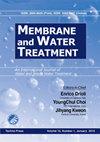沥青和混凝土道路雨水径流中污染物的比较
IF 1.1
4区 工程技术
Q4 ENGINEERING, CHEMICAL
引用次数: 0
摘要
控制非点源污染物是实现良好地表水水质的关键;道路径流的作用最近受到越来越多的关注。本研究监测了npps的径流特征,包括来自沥青和混凝土道路的悬浮固体、粒径分布、重金属、有机物和营养物质。水质参数包括生化需氧量(BOD)、化学需氧量(COD)和接收水库的营养物质。在第一次冲洗期间,混凝土道路的污染物浓度随时间的变化高于沥青道路。浓度在短时间内达到峰值,而污染物浓度在雨后几天可能会增加。混凝土路面的径流浓度和粒径分布较高,而沥青路面和混凝土路面的重金属浓度基本一致。沥青路面的有机质浓度高于或等于混凝土路面的有机质浓度;这可能与道路位置有关。水库水质分析结果显示,BOD、COD、营养物浓度均较好。道路建设是决定npsp在道路径流中的特征的一个因素。本文章由计算机程序翻译,如有差异,请以英文原文为准。
Comparison of pollutants in stormwater runoff from asphalt and concrete roads
Controlling non-point source pollutants (NPSPs) is critical in achieving good surface water quality; the contribution of road runoff has recently received increased attention. This study monitored the runoff characteristics of NPSPs, including suspended solids, particle size distribution, heavy metals, organic matter, and nutrients, from asphalt and concrete roads. Water quality parameters, including biochemical oxygen demand (BOD), chemical oxygen demand (COD), and nutrients of the receiving reservoir, were also investigated. During the first flush, the changes in pollutant concentrations over time were higher on concrete roads than asphalt roads. Concentrations peaked over a short period, while an increased pollutant concentration may be present several days after rain. The runoff concentration and particle size distribution were higher on concrete roads, whereas the concentrations of heavy metals were similar in asphalt and concrete roads. The organic matter concentration of asphalt roads was higher, or identical, to that in the first flush from concrete roads; this may be associated with the road location. Water quality analysis of the reservoir showed relatively good results for BOD, COD, and nutrient concentrations. Road construction was a factor that determined the characteristics of NPSPs in road runoff.
求助全文
通过发布文献求助,成功后即可免费获取论文全文。
去求助
来源期刊

Membrane Water Treatment
ENGINEERING, CHEMICAL-WATER RESOURCES
CiteScore
1.90
自引率
30.00%
发文量
0
审稿时长
>12 weeks
期刊介绍:
The Membrane and Water Treatment(MWT), An International Journal, aims at opening an access to the valuable source of technical information and providing an excellent publication channel for the global community of researchers in Membrane and Water Treatment related area. Specific emphasis of the journal may include but not limited to; the engineering and scientific aspects of understanding the basic mechanisms and applying membranes for water and waste water treatment, such as transport phenomena, surface characteristics, fouling, scaling, desalination, membrane bioreactors, water reuse, and system optimization.
 求助内容:
求助内容: 应助结果提醒方式:
应助结果提醒方式:


